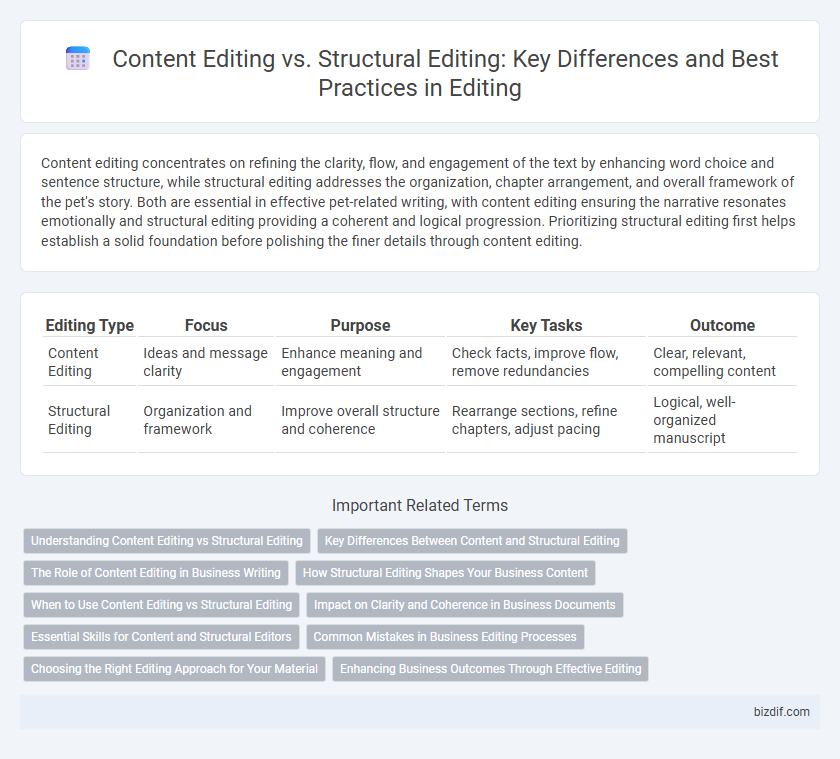Content editing concentrates on refining the clarity, flow, and engagement of the text by enhancing word choice and sentence structure, while structural editing addresses the organization, chapter arrangement, and overall framework of the pet's story. Both are essential in effective pet-related writing, with content editing ensuring the narrative resonates emotionally and structural editing providing a coherent and logical progression. Prioritizing structural editing first helps establish a solid foundation before polishing the finer details through content editing.
Table of Comparison
| Editing Type | Focus | Purpose | Key Tasks | Outcome |
|---|---|---|---|---|
| Content Editing | Ideas and message clarity | Enhance meaning and engagement | Check facts, improve flow, remove redundancies | Clear, relevant, compelling content |
| Structural Editing | Organization and framework | Improve overall structure and coherence | Rearrange sections, refine chapters, adjust pacing | Logical, well-organized manuscript |
Understanding Content Editing vs Structural Editing
Content editing focuses on enhancing the clarity, flow, and tone of the text by refining language, correcting grammar, and ensuring consistency in style and voice. Structural editing examines the overall organization and framework of a document, addressing issues like plot development, chapter arrangement, and logical progression to improve coherence and readability. Understanding the distinction between content and structural editing is essential for targeting specific areas of improvement in a manuscript.
Key Differences Between Content and Structural Editing
Content editing focuses on refining the clarity, tone, and style of individual sentences and paragraphs to enhance readability and engagement. Structural editing addresses the overall organization, flow, and coherence of a manuscript by reorganizing sections, improving transitions, and ensuring logical progression. Key differences lie in content editing's emphasis on language and detail versus structural editing's focus on big-picture narrative framework and architecture.
The Role of Content Editing in Business Writing
Content editing sharpens business writing by enhancing clarity, tone, and relevance to target audiences, ensuring messages align with brand identity. It focuses on refining language, fixing grammar, and improving sentence flow to boost reader engagement and comprehension. This editing stage is crucial for persuasive communication, directly impacting marketing, sales proposals, and internal reports' effectiveness.
How Structural Editing Shapes Your Business Content
Structural editing shapes your business content by organizing ideas for clarity, flow, and impact, ensuring the message aligns with strategic goals. It identifies gaps, redundancies, and inconsistencies in the overall framework, enhancing readability and audience engagement. This editing phase refines the core structure before content editing polishes grammar and style, creating a cohesive and compelling narrative.
When to Use Content Editing vs Structural Editing
Content editing is best used when refining clarity, tone, and the accuracy of information within individual paragraphs or sections, ensuring the message aligns with the intended audience. Structural editing becomes essential during early draft stages or major rewrites, focusing on the overall organization, flow, and coherence of the entire manuscript. Choosing between content editing and structural editing depends on whether the priority is improving detailed content or reorganizing the foundational framework of the work.
Impact on Clarity and Coherence in Business Documents
Content editing enhances clarity by refining language, ensuring precise word choice, and eliminating ambiguity in business documents. Structural editing improves coherence through reorganizing sections, optimizing flow, and aligning information logically to facilitate reader comprehension. Together, these editing approaches significantly boost the effectiveness of business communication by making documents clear, focused, and easy to navigate.
Essential Skills for Content and Structural Editors
Content editing requires a strong command of language, grammar, and style to refine clarity, tone, and flow within paragraphs. Structural editing demands skills in organizing narrative elements, adjusting pacing, and ensuring cohesive story arcs or logical frameworks throughout the entire manuscript or document. Both roles benefit from critical thinking, attention to detail, and the ability to provide constructive feedback tailored to the manuscript's purpose and target audience.
Common Mistakes in Business Editing Processes
Common mistakes in business editing processes often arise from confusing content editing with structural editing, leading to incomplete revisions that overlook key narrative flow issues. Content editing targets clarity, grammar, and style consistency, while structural editing addresses organization, logical progression, and overall document architecture. Failing to differentiate these editing stages can result in documents that are grammatically sound but lack coherence and persuasive impact.
Choosing the Right Editing Approach for Your Material
Content editing focuses on refining the clarity, tone, and accuracy of the text to enhance reader engagement, while structural editing addresses the organization, flow, and overall framework of the material to ensure coherence. Selecting the right approach depends on the manuscript's current state, with content editing suited for polished drafts requiring fine-tuning, and structural editing necessary for works needing major reorganization or conceptual development. Understanding the distinct goals of each editing type empowers writers to improve their material efficiently and create a compelling narrative.
Enhancing Business Outcomes Through Effective Editing
Content editing focuses on refining language, tone, and clarity to ensure the message resonates with the target audience, while structural editing reorganizes and shapes the overall framework to enhance flow and coherence. Businesses that integrate both content and structural editing achieve higher engagement, stronger brand consistency, and improved conversion rates. Leveraging these editing techniques drives impactful communication that supports strategic business growth and customer satisfaction.
Content Editing vs Structural Editing Infographic

 bizdif.com
bizdif.com